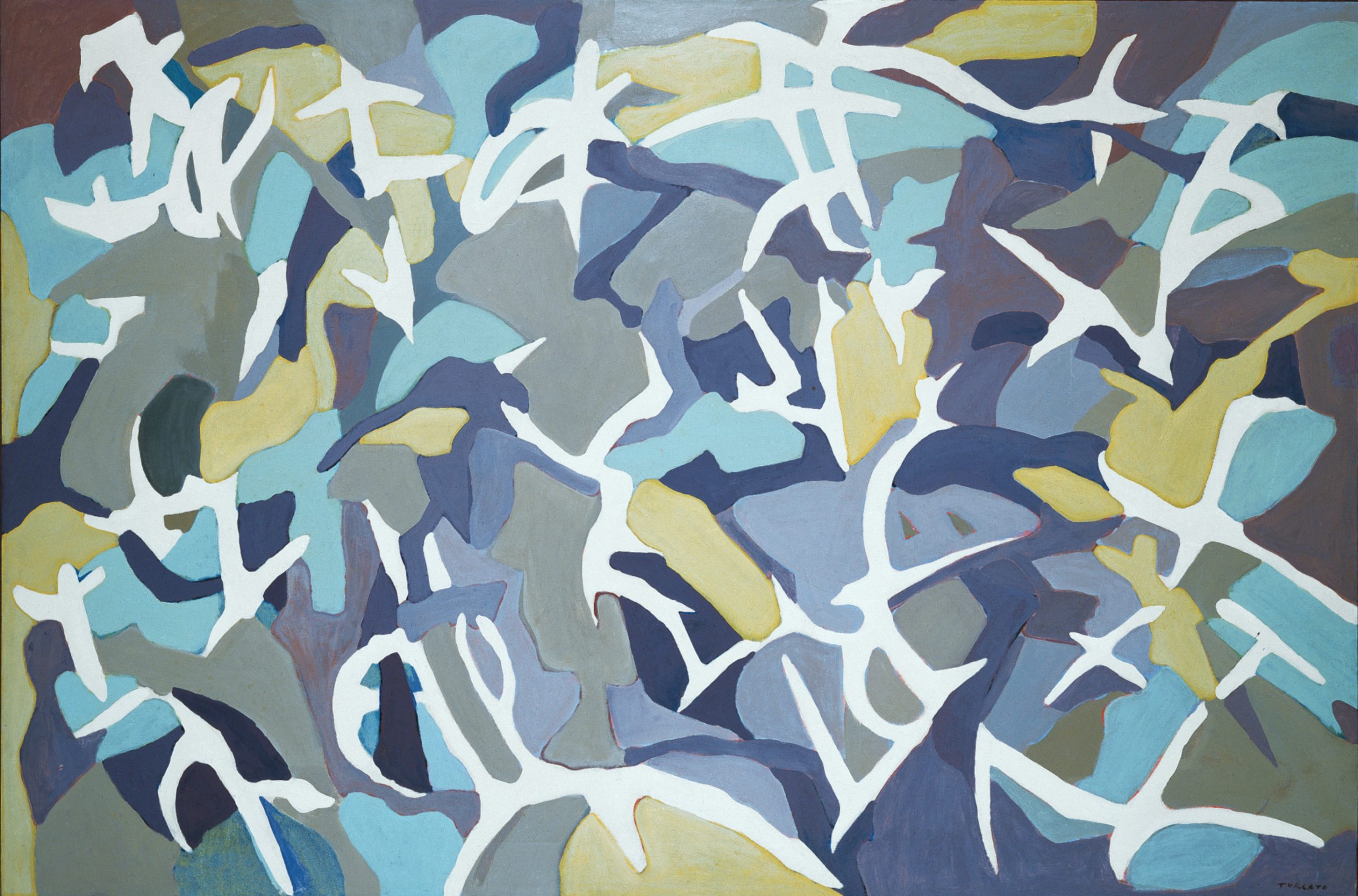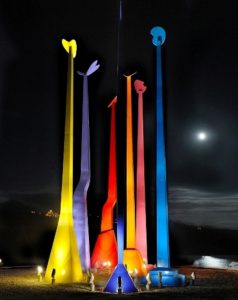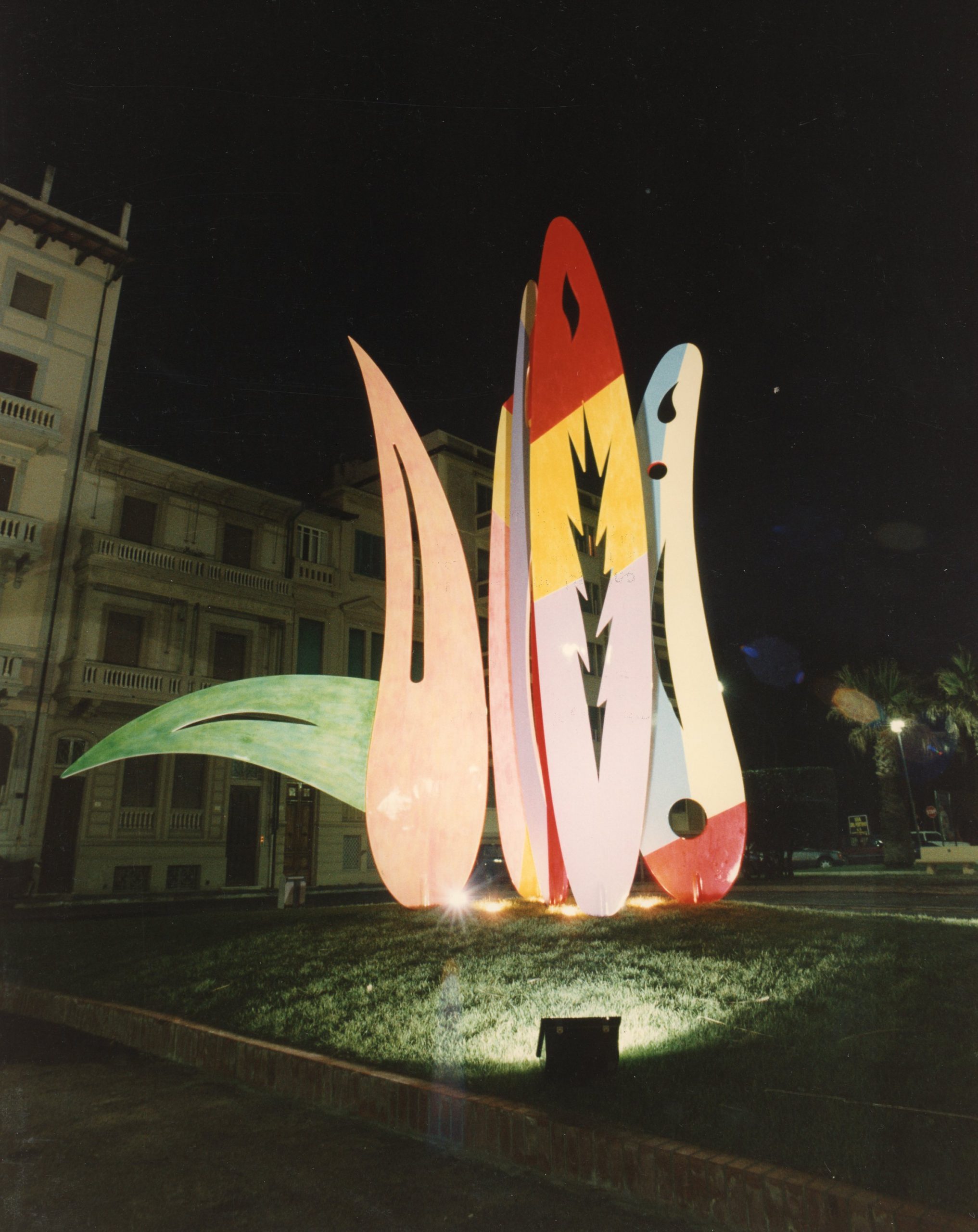BIOGRAPHY

I have imagined colours beyond the spectrum, colours that cannot be seen, but that can be felt when placed together even in extreme terms, invented colours because they roam the terrestrial aura and beyond.
Giulio Turcato
Giulio Turcato was born to Venetian parents in Mantua on 16 March 1912. The family moved to Venice when he was eight years old, where he attended the Liceo Artistico and, subsequently, the Scuola Libera del Nudo.
At the age of twenty-two, he was conscripted into the army and sent to Palermo, where he contracted tuberculosis. The disease plagued him for nearly a decade subjecting him to intermittent bouts of pneumonia during which he was forced to rest. His close rapport with illness revealed to him a biological world of invisibility. He remarked that 'such a state made me think that one cannot attribute precise and theoretical elements to everything we see.' Microbes, bacteria and the filaments of life invisible to the naked eye recurred in his paintings later in life, such as Composizione biologica and Batteriologico in 1960, or Composizione microbica in 1961. In the periods he did not spend in sanatoriums, Turcato began showing his paintings in group shows and moved from Venice to Milan in 1936, where he would have his first solo show in 1937 exhibiting Natura morta.
He worked as a draughtsman for the architect Giovanni Muzio, the inventor of Nuovo Design with Giò Ponti. He knew artists in Corrente, a group of anti-Fascist intellectuals including Elio Vittorini and Renato Guttuso. With many of them, Turcato would join the Resistance in 1943 and move to Rome, where he helped sort and distribute copies of l’Unità. The Communist daily would sponsor the exhibition L’Arte contro le barbarie held in August 1944 at the Galleria di Roma, where Guttuso, Mafai, Turcato and others reinterpreted famous revolutionary paintings.
At the age of twenty-two, he was conscripted into the army and sent to Palermo, where he contracted tuberculosis. The disease plagued him for nearly a decade subjecting him to intermittent bouts of pneumonia during which he was forced to rest. His close rapport with illness revealed to him a biological world of invisibility. He remarked that 'such a state made me think that one cannot attribute precise and theoretical elements to everything we see.' Microbes, bacteria and the filaments of life invisible to the naked eye recurred in his paintings later in life, such as Composizione biologica and Batteriologico in 1960, or Composizione microbica in 1961. In the periods he did not spend in sanatoriums, Turcato began showing his paintings in group shows and moved from Venice to Milan in 1936, where he would have his first solo show in 1937 exhibiting Natura morta.
He worked as a draughtsman for the architect Giovanni Muzio, the inventor of Nuovo Design with Giò Ponti. He knew artists in Corrente, a group of anti-Fascist intellectuals including Elio Vittorini and Renato Guttuso. With many of them, Turcato would join the Resistance in 1943 and move to Rome, where he helped sort and distribute copies of l’Unità. The Communist daily would sponsor the exhibition L’Arte contro le barbarie held in August 1944 at the Galleria di Roma, where Guttuso, Mafai, Turcato and others reinterpreted famous revolutionary paintings.

Turcato was at the vanguard of artistic developments and in touch with the international art world in the decade that followed the liberation of Italy. He founded or joined experimental art movements and groups, from Enrico Prampolini's Art Club (1945) to the Fronte Nuovo delle Arti (1946) directed by Giuseppe Marchiori. Palma Bucarelli's exhibition Pittura francese d’oggi in 1946 at the Galleria Nazionale d’Arte Moderna and a trip to Paris that same year funded by the Communist organisation Fronte nazionale della gioventù opened up his horizons to the influences of the international avant-garde, such as Arp, Picasso and Kandinsky.
With his co-travellers, who included Carla Accardi, Pietro Consagra and Piero Dorazio, Turcato founded the 'Marxist and formalist' group Forma 1 (1947), questioning accepted Communist positions on figurative art. Turcato's work was included in the first Venice Biennale after the war in 1948, where he exhibited four abstract paintings - part of a series of Composizioni - in the Italian Pavilion.
With his co-travellers, who included Carla Accardi, Pietro Consagra and Piero Dorazio, Turcato founded the 'Marxist and formalist' group Forma 1 (1947), questioning accepted Communist positions on figurative art. Turcato's work was included in the first Venice Biennale after the war in 1948, where he exhibited four abstract paintings - part of a series of Composizioni - in the Italian Pavilion.

This year corresponded to a tumultuous time for Italian politics, when the Italian Communist Party (PCI) fought for supremacy against the Christian Democratic Party (DC). Communist cultural strategies tightened: PCI artists were expected to reproduce socialist realist styles and avoid abstraction. As can be seen in his search for an independent style between 1946 and 1956, Turcato was torn between abstraction and realism.
Turcato's allegiance to the PCI was strengthened with a visit to Poland in 1948, with 40 Italian delegates to the First Global Congress for Intellectuals for Peace held in Wroclaw. This journey produced his series Rovine di Varsavia. In the 1950 Venice Biennale Turcato's Comizio, a non-representational rally of Communist flags, was exhibited as part of the Fronte Nuovo delle Arti in a room dedicated to abstract artists.
Turcato's allegiance to the PCI was strengthened with a visit to Poland in 1948, with 40 Italian delegates to the First Global Congress for Intellectuals for Peace held in Wroclaw. This journey produced his series Rovine di Varsavia. In the 1950 Venice Biennale Turcato's Comizio, a non-representational rally of Communist flags, was exhibited as part of the Fronte Nuovo delle Arti in a room dedicated to abstract artists.
As Cold War paranoia rose, Turcato's work manifested an intrinsic friction between his attachment to Communist ideology and his desire to engage with the new centre of the art world - New York.
In 1952, during the Korean War, Turcato painted Insetti dell’epidemia (1952) and Massacro al Napalm (1952), which acted as implicit anti-American condemnations of alleged biological warfare attacks by the United States on North Korea. That same year, the artist joined Lionello Venturi's Gruppo degli otto with, amongst others, Antonio Corpora and Emilio Vedova.
After spending six months in China on a PCI-funded art trip in 1956, Turcato painted Il Deserto dei Tartari and began his series of Reticoli. Turcato left the PCI because of the lack of freedom of expression for artists. As Turcato’s art evolved towards abstraction and experimentation with colour, fluorescence and form, his fame rose: in 1958 he was offered a personal room at the XXIX Venice Biennale; in 1959 he exhibited at Documenta II; and in 1961, with the support of Giulio Carlo Argan, he had a show at the New Vision Centre in London.
After spending six months in China on a PCI-funded art trip in 1956, Turcato painted Il Deserto dei Tartari and began his series of Reticoli. Turcato left the PCI because of the lack of freedom of expression for artists. As Turcato’s art evolved towards abstraction and experimentation with colour, fluorescence and form, his fame rose: in 1958 he was offered a personal room at the XXIX Venice Biennale; in 1959 he exhibited at Documenta II; and in 1961, with the support of Giulio Carlo Argan, he had a show at the New Vision Centre in London.
Turcato began including fake American dollar bills, as in Composizione Argento Con Dollaro in 1962, the year he travelled to New York. However, the idea that really captured the artist's imagination, beyond the science of economics, was the science of astronomics, the flight into space. By 1961, the year the Soviet cosmonaut Yuri Gagarin and the American astronaut Alan Shephard orbited the earth within one month of each other, Turcato had painted Astronomica (1959), Cosmogonia (1960) and Tranquillanti per il mondo (1961). Having heard that colour was perceived differently in outerspace, Turcato began experimenting with his series Fuori dallo spettro ('beyond the spectrum') in 1962.
n 1964, the same year that Robert Rauschenberg won the Venice Biennale with his pop art collage Retroactive I, Turcato produced his first Superficie Lunare, made from discarded slices of foam mattresses that imitated the pocked surface of the moon.
n 1964, the same year that Robert Rauschenberg won the Venice Biennale with his pop art collage Retroactive I, Turcato produced his first Superficie Lunare, made from discarded slices of foam mattresses that imitated the pocked surface of the moon.

That year Turcato and the cineaste Vana Caruso were married. The artist then joined Vana in Egypt where she was working with John Huston on The Bible. After the trip, he painted Porta d’Egitto and Pronunciamento, both shown at the Marlborough Gallery in Rome in October 1965. A trip to Kenya in 1970 inspired his first series of Oceaniche. These sculptures were exhibited at the 1972 Venice Biennale.
As an internationally affirmed artist, Turcato expanded his creative boundaries, designing jewels and theatre sets, which culminated in the modern dance performance Moduli in Viola/Omaggio a Kandinsky. This was first staged during the Venice Biennale in 1984 at the Teatro Goldoni with Luciano Berio’s musical compositions and Min Tanaka’s choreography and subsequently in Taormina in 1985 at the Teatro Antico with a choreography by Yamanouchi.
Turcato’s paintings from the 1980s and early 1990s continuously sought other dimensions in his experimentation with colour, texture, techniques and sculptural elements.
Turcato’s paintings from the 1980s and early 1990s continuously sought other dimensions in his experimentation with colour, texture, techniques and sculptural elements.


The last significant solo exhibition was Vedendo at the Banchi Nuovi gallery in Rome in 1992 showing works such as Dune and Le Pacte Signal. In 1994, his works were included in Germano Celant’s exhibition The Italian Metamorphosis: 1943 – 1968 at the Guggenheim in New York. Soon after the closure of the show his eulogy appeared in The New York Times: Giulio Turcato, ‘a prominent member of Italy’s post-war avant-garde’, died aged 83 on 22 January 1995 at his home in Rome in Via del Pozzetto. He had migrated there from his studio in the 'little kasbah' of Via Margutta n. 48 where he had lived his early years.
